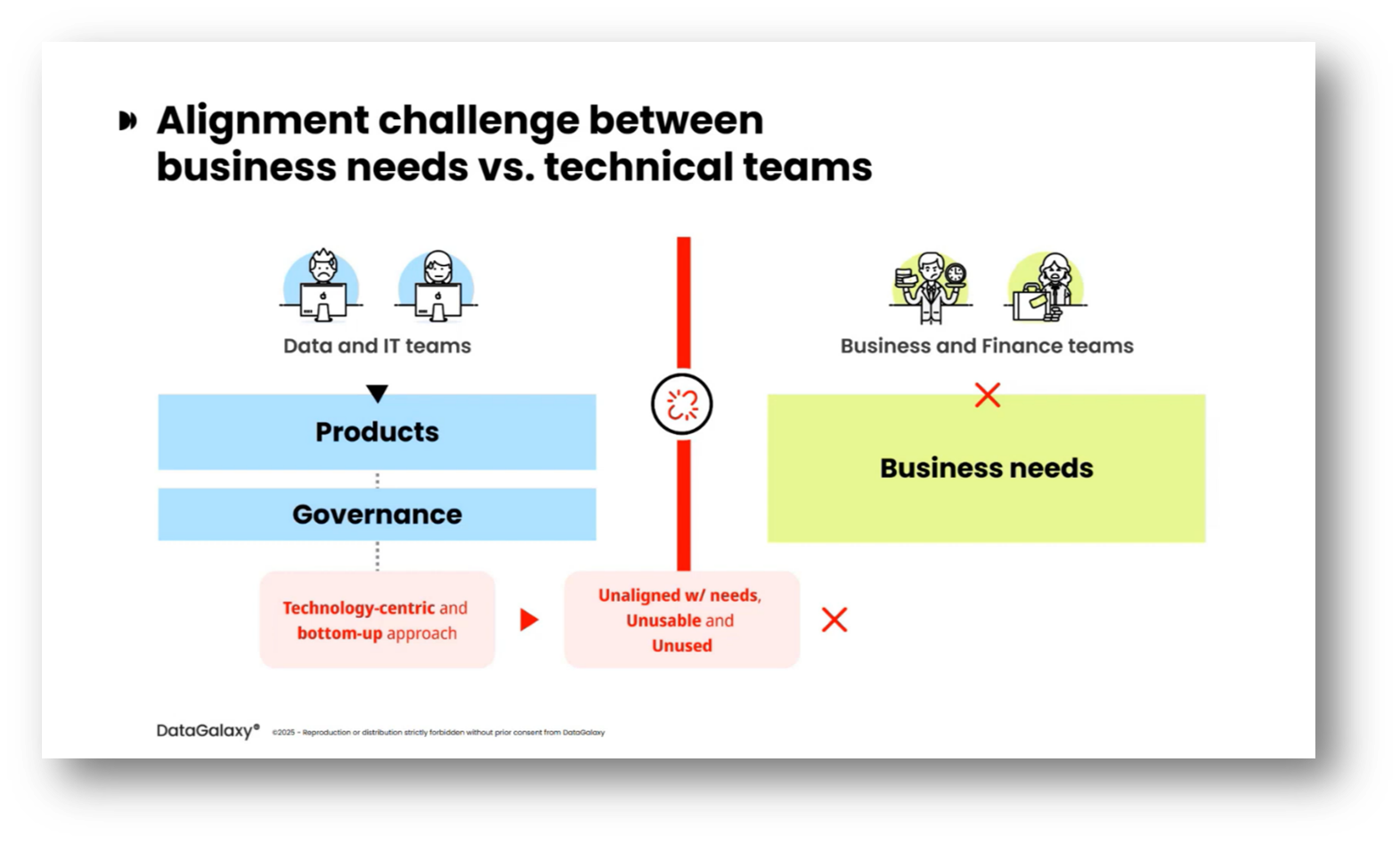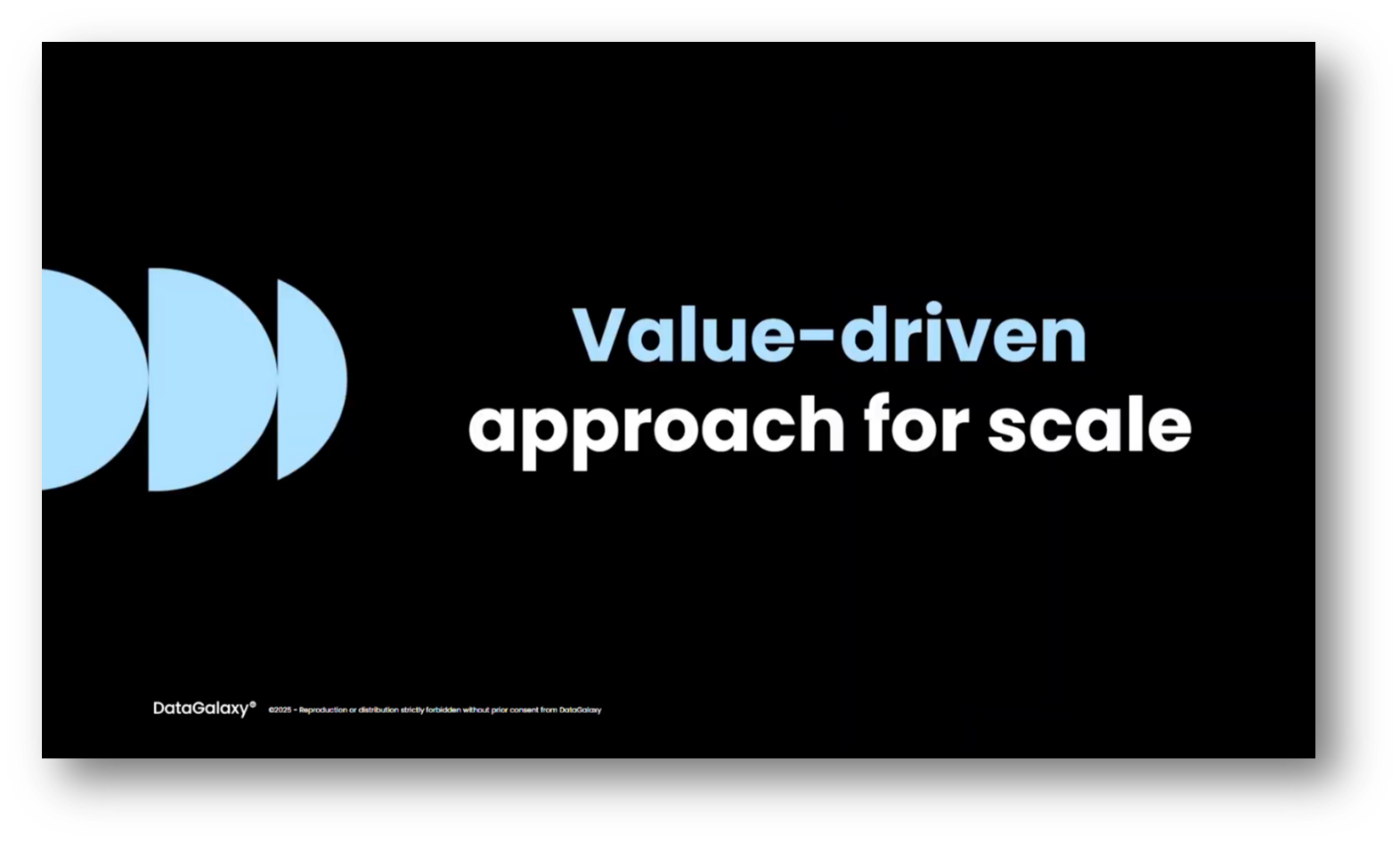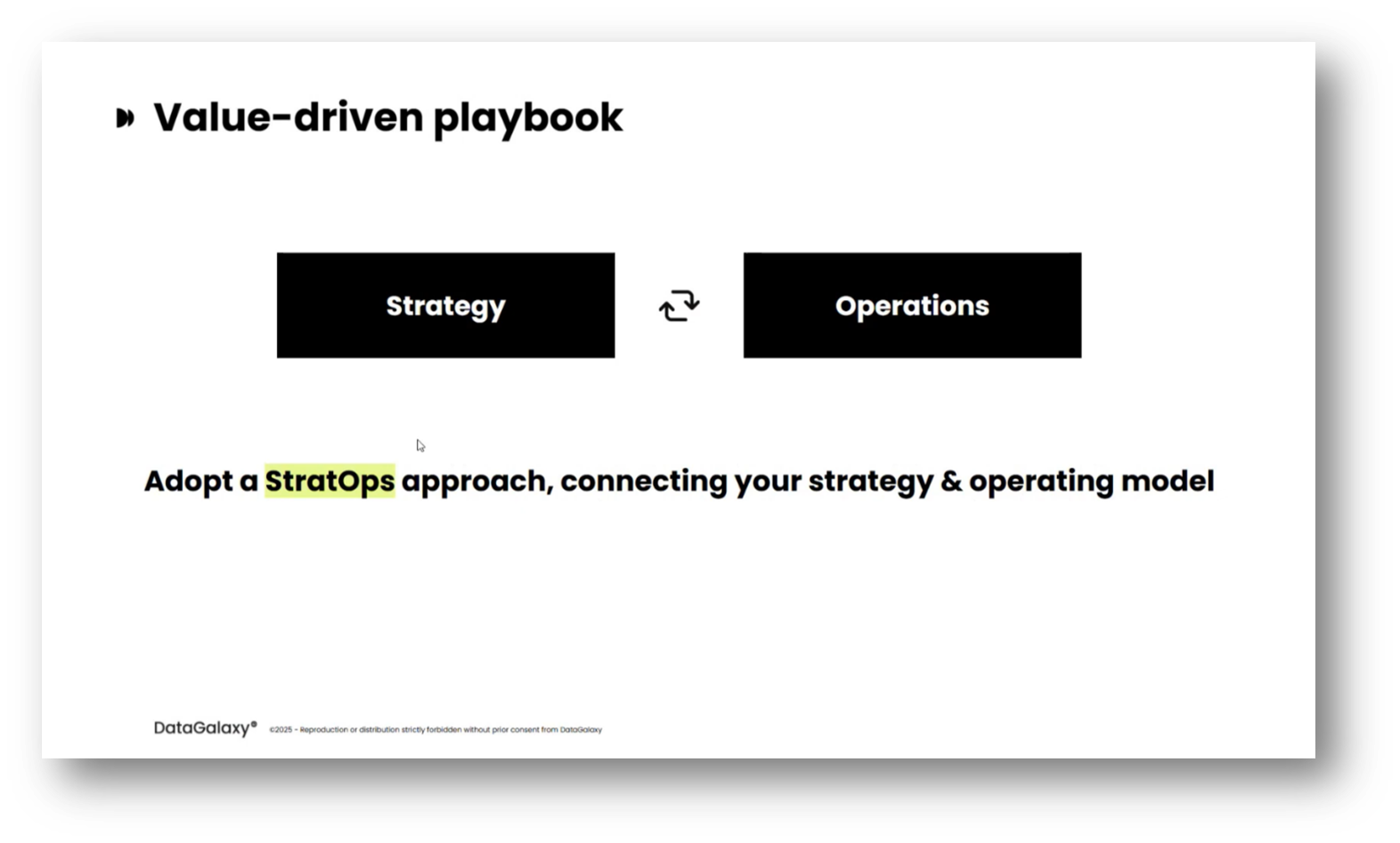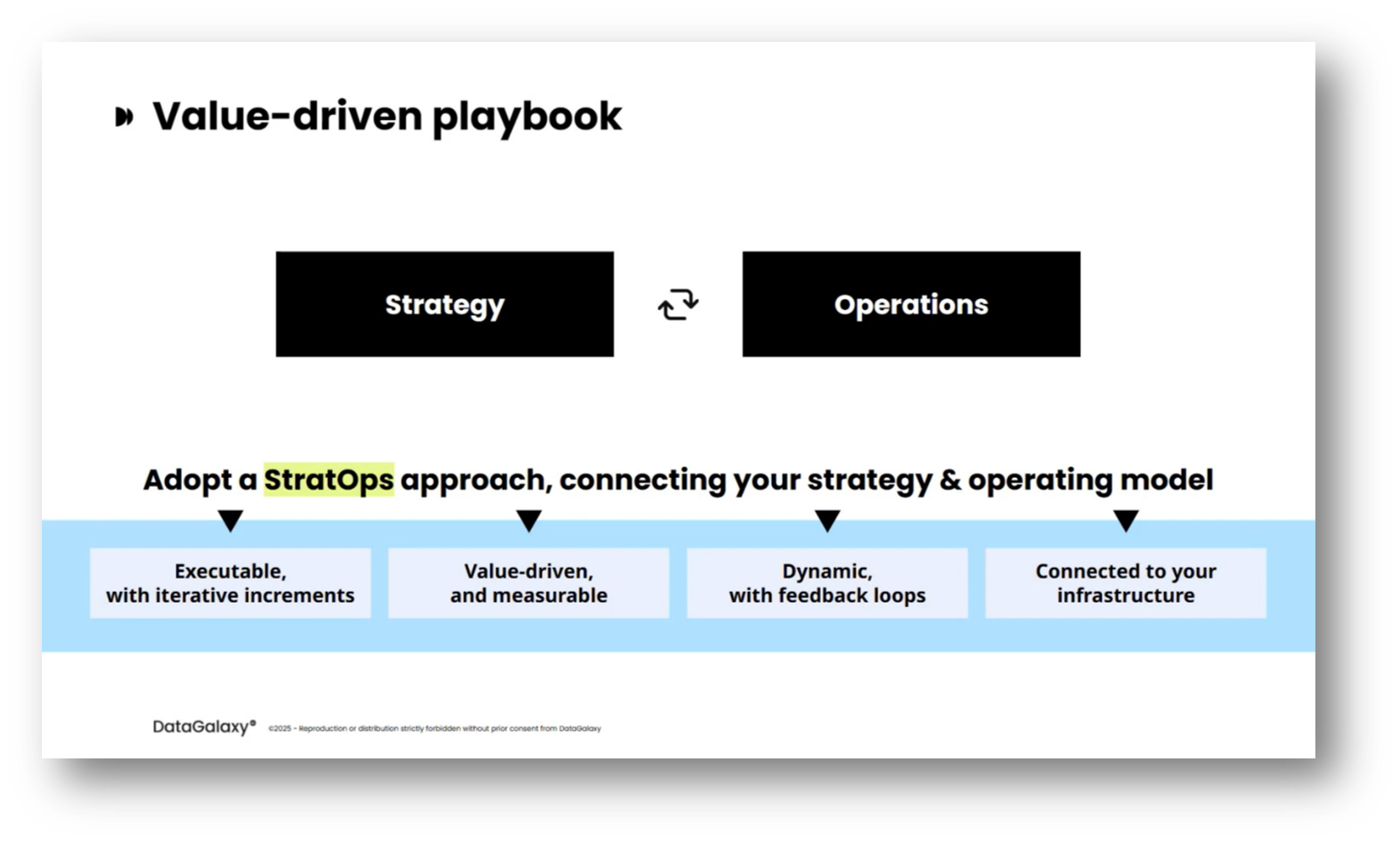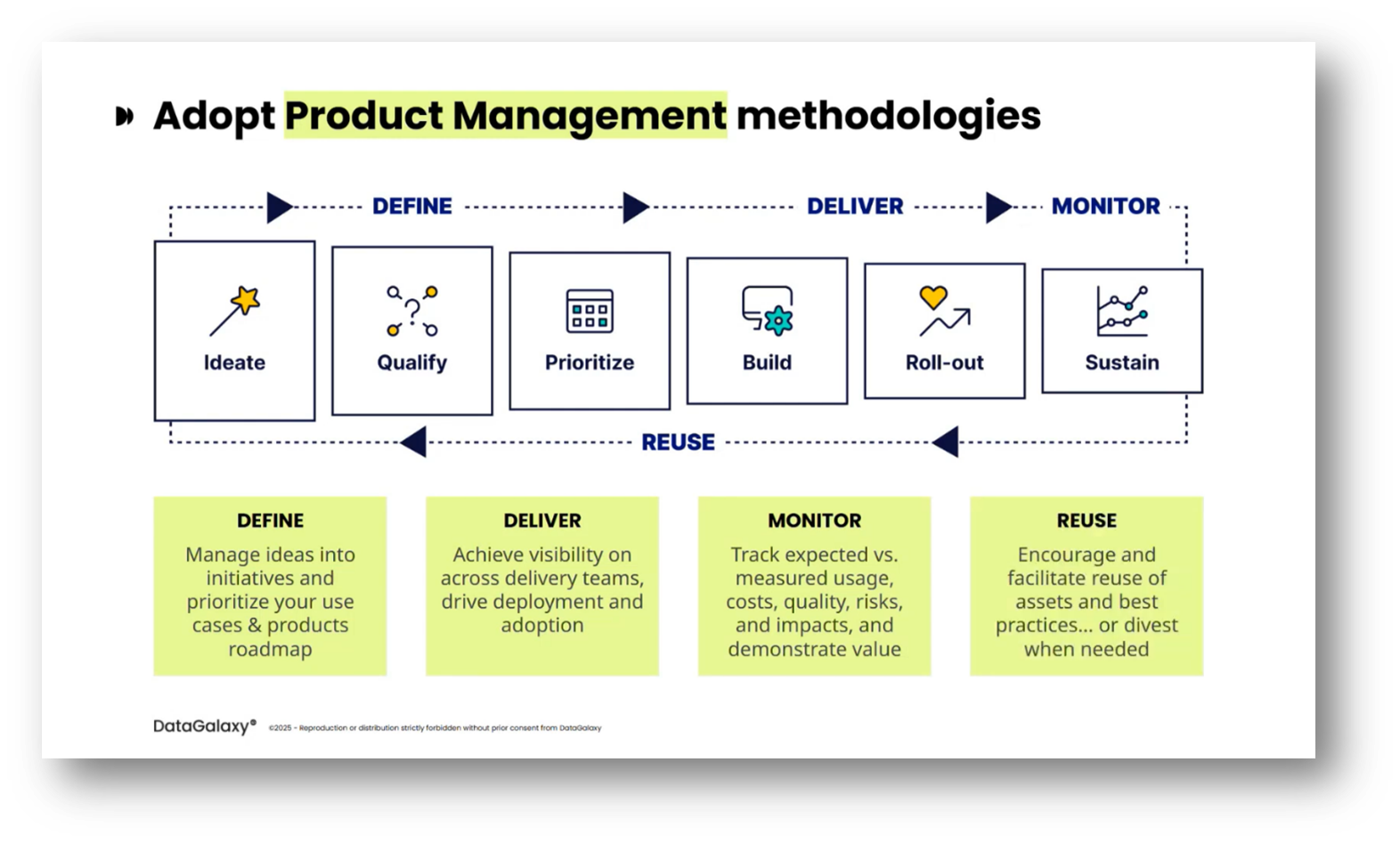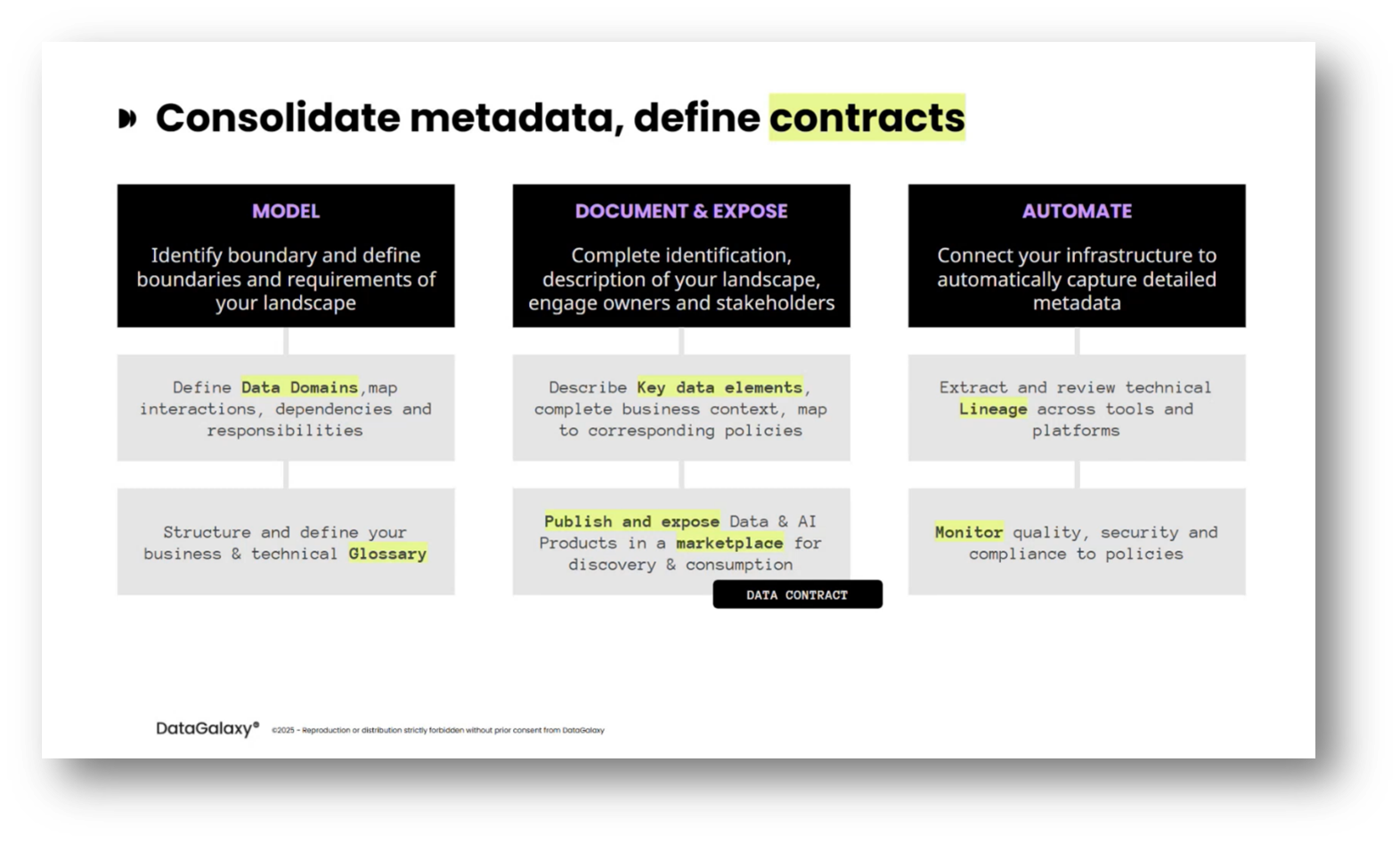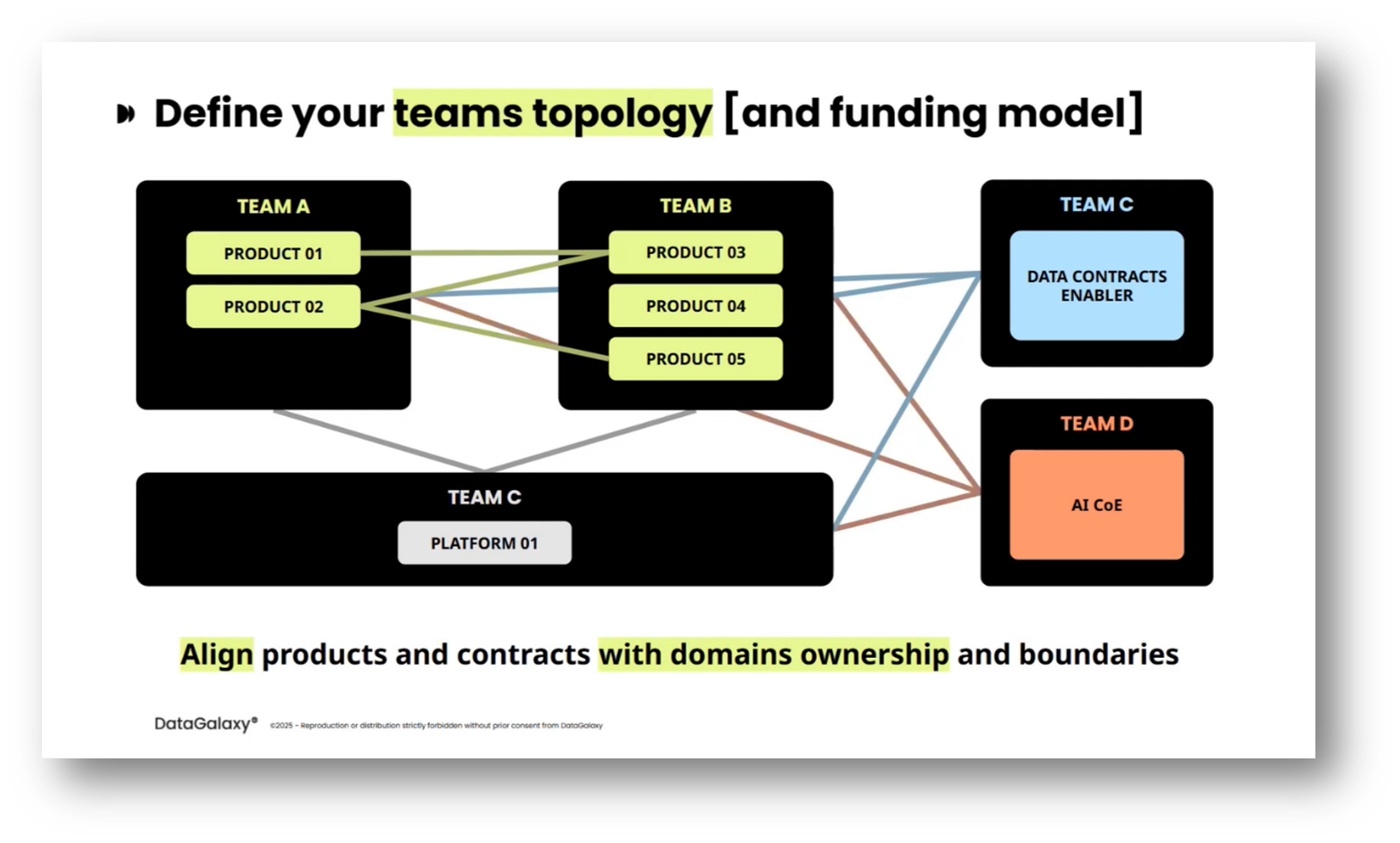Delivering value at scale with Data and AI products with Nicolas Averseng
Executive Summary
This webinar outlines key aspects of data product implementation and management, emphasising the importance of understanding dynamic data characteristics and differentiating between data and AI products. Nicolas Averseng highlights the role of data in developing these products and the necessity of strategies for successful adoption and maintenance. Additionally, critical themes such as risk assessment, value delivery, and organisational structure in data and AI product development are discussed, along with the value contribution and ROI associated with business technology.
A value-driven approach is recommended to address the disconnect between data and business teams while bridging the gap between strategy and operations. In this webinar, Nicolas explores the significance of product management methodologies and data contracts, alongside the roles of users and owners in product development, risk management, and data governance. He concludes by emphasising the importance of aligning budget management with accountability and integrating data governance with business objectives to enhance decision-making processes.
Webinar Details
Title: Delivering value at scale with Data and AI products with Nicolas Averseng
Date: 09 June 2025
Presenter: Nicolas Averseng
Meetup Group: INs and OUTs of Data Modelling
Write-up Author: Howard Diesel
Contents
Nicolas Averseng and Data Product Implementation
Understanding the Characteristics of Dynamic Data Products
How to Distinguish Data and AI Products
Role of Data in AI and Data Product Development
Strategies for Data Product Adoption and Maintenance
Risk Assessment, Value Delivery, and Organisational Structure in Data & AI Product Development
Value Contribution and ROI in Business Technology
Addressing the Disconnect between Data and Business Teams: A Value-Driven Approach
Bridging the Gap between Strategy and Operations
The Importance of Product Management Methodologies
The Role and Importance of Data Contracts in Data Products
Implementing Data Product Management
Understanding the Role of Users and Owners in Data Product Development
Journey of Data Product Adoption
The Application of Value Lineage in Business Education
Risk Management and Data Governance in Software Development
Team Topology and Alignment in Data Practice
The Scalability of Data Contracts in AI and Data Product Adoption
Data Product Management and Budget Management in Business
Balancing Budget and Accountability in the Business
Data Governance and Data Strategy in Business
Business Objectives and the Decision-Making Process
Nicolas Averseng and Data Product Implementation
Howard Diesel opens the webinar and expresses gratitude to Nicolas Averseng. Nicolas shares his encouragement of an interactive session and indicates a readiness to share his slides. He adds that he wants to demonstrate aspects of the product to support his points.
Understanding the Characteristics of Dynamic Data Products
Dynamic Data products encompass a variety of elements beyond just datasets, combining data, analytics, and AI to deliver value to target users. To be effective, these products must be reliable, manageable over time, and directly linked to business needs and tangible use cases. Additionally, key criteria for dynamic products include their ability to provide consistent value, the necessity for ongoing management and monitoring, and the integration of various components that collectively enhance value delivery. Removing any of these elements undermines the product's purpose and effectiveness.
Figure 1 "Creating value at scale with Data & AI products at scale"
Figure 2 Why are Data & AI Products so Promising?
Figure 3 But Scaling Data & AI Products is Hard!
How to Distinguish Data and AI Products
The distinction between data products and AI products can be nuanced, as they share many commonalities; however, AI introduces specific complexities that warrant differentiation. While traditional data analytics primarily deals with data quality and changes, AI products raise additional concerns related to trustworthiness, potential data drift, regulatory compliance, and ethical responsibilities.
These factors significantly expand both technical and organisational considerations. Therefore, while the terms "data" and "AI" can be used interchangeably to some extent, it is essential to recognise that AI involves unique challenges and insights that contribute to delivering value.
Role of Data in AI and Data Product Development
Nicholas discusses the distinction between data and AI products, acknowledging that data can serve as either a standalone product or an integral component of an AI product. He emphasises that when data is solely used as an input for an AI model, it does not need to be delivered to consumers as part of the product output.
This creates a distinction in product packaging, where the focus is on what is provided to the consumer rather than the internal data processes. Additionally, he highlights that challenges can arise when organisations seek to adopt such products, which may complicate the integration of data and AI solutions.
Figure 4 But Scaling Data & AI Products is Hard! Pt.2
Strategies for Data Product Adoption and Maintenance
When selecting a product or initiative from potentially hundreds of options, it’s crucial to adopt a disciplined approach to address scalability and ensure effective adoption. The product must meet the three criteria of being useful (delivering value), usable (fitting seamlessly into users' workflows), and used (integrated into daily tasks). Additionally, considerations for the ongoing reuse, maintenance, and evolution of the product are essential, including the processes and teams required, as well as appropriate budgeting. Often, insufficient budgeting leads to a lack of maintenance, resulting in decreased adoption and eventual disengagement from users.
Figure 5 But Scaling Data & AI Products is Hard! Pt.3
Risk Assessment, Value Delivery, and Organisational Structure in Data & AI Product Development
The effective assessment of Data Governance risk and compliance is increasingly crucial, particularly in the context of AI products, as it should be integrated throughout the product lifecycle rather than just at inception. This ongoing risk assessment informs necessary control mechanisms and guides decisions on product value, such as whether to reuse, reinvest in, or discontinue a product that isn't delivering the expected benefits.
Organisations must balance the creation of new products with the discipline of knowing when to stop underperforming ones. Furthermore, a clear structure regarding roles and accountability related to product development, consumption, and funding is essential for operating products at scale.
Figure 6 But Scaling Data & AI Products is Hard! Pt.4
Figure 7 Alignment Challenge Between Business Needs Vs. Technical Teams
Value Contribution and ROI in Business Technology
Nicolas highlighted the limitations of using Return on Investment (ROI) as the sole metric for tracking value contribution in product management, emphasising that ROI, being a purely financial metric, may not adequately reflect transformative value. Instead, he suggests employing alternative metrics, such as OKRs (Objectives and Key Results), that facilitate a clearer understanding of how teams can impact business outcomes.
This recognises the importance of both direct and indirect contributions of data offices to business deliverables. Nicolas illustrates this further with the example of using AI models to reduce customer churn. He points out that many organisations, while lacking concrete ROI figures for systems like CRM, still leverage them due to their operational relevance.
In the process of measuring the effectiveness of an AI system in reducing customer churn, Nicolas emphasised that while direct dollar valuation per churn point is possible, operational teams benefit more from understanding how AI contributes to churn reduction. He then added this by recommending, again, the use of OKRs (Objectives and Key Results) as a more streamlined approach compared to the balanced scorecard, highlighting that organisations may track value differently.
Nicolas notes that aligning value measurement with existing organisational frameworks—whether OKRs, balanced scorecards, or financial metrics—is essential. For instance, one client monitored top-line metrics such as operational efficiency and CO2 reduction, the latter of which was not assigned a dollar value but nonetheless held significant importance in digital initiatives reported to their board.
Addressing the Disconnect between Data and Business Teams: A Value-Driven Approach
A significant disconnect often exists between data and IT teams and business and finance teams within organisations, leading to challenges in data product adoption. A survey indicated that while 92% of chief data officers believe they deliver value, 92% of IT and business teams disagree, highlighting frustrations over unmet needs and untimely delivery.
Alarmingly, recent research shows that 75% of data investments created for business purposes have either failed or remain unused, signifying a substantial waste of resources. To address these issues, a value-driven approach to designing and delivering data products is essential, as it fosters better alignment with business requirements and enhances adoption rates.
Figure 8 Gartner: "75% of Data & AI investments fail or are unused"
Figure 9 Value-Driven Approach for Scale
Figure 10 Value-driven Playbook
Bridging the Gap between Strategy and Operations
To address the challenges of aligning strategy with operations, we propose a concept called the value-driven playbook, utilising the StratOps (Strategic Operations) approach. This model emphasises the importance of bridging the gap between dynamic strategies, often confined to presentations, and the operational execution that can feel disconnected. Just as DevOps and DataOps integrate development and deployment processes for improved quality and efficiency, StratOps aims to create a seamless connection between strategic vision and operational implementation.
By enabling strategies that are executable in small increments, measurable, and informed by feedback loops from production, organisations can enhance their ability to monitor and refine their strategies based on real-world outcomes. This approach emphasises the importance of automation and coherence with infrastructure, ensuring that every action aligns with strategic objectives.
Figure 11 Value-driven Playbook Pt.2
The Importance of Product Management Methodologies
To effectively manage a product, it’s essential to adopt a consistent product management methodology. This involves defining a product as something that is actively managed over time, encompassing the entire lifecycle from demand capture and prioritisation to design, deployment, and ongoing monitoring.
A coherent framework is crucial for scaling efforts, ensuring that all aspects—how we define, deliver, and monitor products—are aligned. Without this framework, inconsistencies may arise across different teams, making it challenging to support discussions and decision-making regarding product reuse or discontinuation.
Figure 12 Adopt Product Management Methodologies
Figure 13 Deploy Frameworks & Work Flows as Live Guidelines
The Role and Importance of Data Contracts in Data Products
Nicolas highlights differing views on the definition of a data product, particularly in relation to data contracts. One perspective argues that a data product cannot simply be defined as having a data contract; instead, the contract serves merely as a tool to enhance product deliverability, rather than being the essence of the product itself. He emphasises that having a well-structured product could exist independently of data contracts, and the latter is instrumental for standardising discoverability and technical scalability. Additionally, an attendee adds that it is necessary to distinguish between IT data contracts and business data contracts when presenting data initiatives, particularly from a CIO's perspective.
While acknowledging that an IT data contract is a valuable concept that may require clearer differentiation through prefixes, this emphasises the importance of implementing a business data contract to deliver tangible business value. Additionally, an attendee shares their own insights on data fabric and data products, suggesting that understanding contracts involves defining both business and technical aspects.
Lastly, Nicolas highlights that while initial data product delivery can occur without a formalised contract, scaling and automation will ultimately necessitate a focus on IT frameworks to enhance standardisation in data consumption.
Implementing Data Product Management
The data product management process begins with the data product canvas, which aids in discovering and framing a data product. It focuses on three main areas: first, understanding the problem space by identifying the specific problem to be solved and the target consumers, as well as the actions consumers will take based on the product insights derived from the necessary data inputs; second. Secondly, outlining the solution, which could involve creating dashboards, datasets, or advanced models, based on the identified user needs. And thirdly, evaluating value by aligning the product with strategic business objectives while considering risks such as regulatory compliance and internal policies, and establishing measurements to ensure the product delivers its intended value and mitigates potential risks.
Figure 14 Deploy Frameworks & Workflows as Live Guidelines
Understanding the Role of Users and Owners in Data Product Development
“Users” and “owners” of a data product must be distinguished to represent two different personas. Nicolas highlights the importance of identifying who will own the product in terms of delivery while also considering who the actual users are. Additionally, there is a suggestion that the framework should clarify these roles and their interactions, as understanding the needs of both users and owners is crucial for successful product development.
The term "owner" is viewed with some scepticism, as it can imply a narrower, product-centric view, whereas the focus should be on creating value for the end users. The key to successful product adoption lies in focusing on target users rather than just the budget owner or stakeholders. While it is essential to ensure that the sponsor, who typically manages the budget, is satisfied, the primary emphasis should be on meeting the needs and preferences of the end users.
This approach is critical because achieving user adoption is the ultimate goal, necessitating thorough consideration of who will engage with the product. Clear definitions of roles, such as users and sponsors, should be established to avoid confusion, ensuring that the product aligns with the expectations and requirements of its intended audience.
Journey of Data Product Adoption
The need for engaging users throughout the development journey emphasises the concept of adoption as a campaign rather than a straightforward product launch. Nicolas emphasises the importance of involving key users early in the discovery phase to ensure they feel ownership of the solution, thereby fostering adoption from the outset.
Key elements for successful adoption include providing necessary training and process changes, along with suggestions for incorporating an adoption or rollout plan within the framework. Additionally, the idea of introducing an iterative adoption box along the project timeline is considered beneficial for user comfort, while also acknowledging the challenge of measurement and the need for detailed guidelines to navigate this complexity.
Figure 15 Deploy Frameworks & Workflows as Live Guidelines Pt.2
The Application of Value Lineage in Business Education
The value lineage is a pivotal tool that establishes a clear connection between business goals and objectives, such as KPIs and use cases, and the products being developed. Although it may appear simple, it plays a crucial role in educating business users about data and AI initiatives while also informing technical teams about the alignment of their efforts with strategic objectives.
This map of value lineage complements more technical lineage, allowing organisations to link qualitative insights to quantified measures. It consolidates information across various canvases and product IDs, ensuring that the value derived from different projects is manageable and comprehensible.
Risk Management and Data Governance in Software Development
To achieve consistent risk assessment across various tools, it’s essential to provide guided checklists that align with complex regulations, such as the European AI Act, GDPR, and local regulations like those of the Saudi NDMO. This approach not only helps users align their use cases with internal policies and AI guidelines but also assists in identifying necessary controls for automation over time, ensuring compliance with requirements.
Establishing a comprehensive decision-making framework across products is crucial for agile operations, enabling organisations to evaluate and adjust product strategies effectively. By defining data domains, glossaries, and documenting key data elements aligned with policies, organisations can create trustworthy data products for consumption. Additionally, automation plays a crucial role in maintaining technical lineage and enforcing quality rules, thereby facilitating scalable and efficient governance across both the infrastructure and product layers.
Figure 16 Deploy Frameworks & Workflows as Live Guidelines Pt.4
Figure 17 Consolidate Metadata, Define Contracts
Team Topology and Alignment in Data Practice
Team topology, a concept outlined in a well-regarded book of the same name, emphasises its importance in establishing effective data practices. Nicolas suggests linking team structure to domain boundaries by assigning different teams to various products, while also considering the need for platform teams that support these product teams. Additionally, enabler teams can be created to standardise data contracts and help integrate emerging capabilities, such as AI, across products.
Acknowledging alignment and collaboration challenges as primary issues rather than technical ones, the conversation emphasised the need to build systems that facilitate alignment and prioritisation across teams and departments, ensuring the successful adoption and long-term management of initiatives.
Figure 18 Define your Teams Topology
Figure 19 Aligning Teams, so Everyone at Every Level Can Act with Confidence, Clarity and Purpose
The Scalability of Data Contracts in AI and Data Product Adoption
Data Contracts are a crucial tool for scaling data product adoption. While not the initial starting point, data contracts facilitate legal compliance and enable teams globally to enhance their data strategies. Nicolas also highlights the distinction between data products and AI products, suggesting that different output formats—such as feature stores for machine learning systems and dashboards for user interfaces—represent diverse "output ports" of the same underlying data product. Additionally, this multifaceted approach to defining outputs is key to effectively maximising the utility of data resources.
Data Product Management and Budget Management in Business
Effective product management relies on a robust prioritisation framework that prevents constant shifts in project scope, which often occur when managers allocate resources to meet departmental goals. It is crucial to align teams through a systematic approach that assesses feasibility, potential value, cost, and risk, avoiding decisions based solely on the opinions of the highest-paid individuals—a scenario referred to as the "HiPPO" (the Highest Paid Person’s Opinion) decision.
Breaking projects into smaller, executable increments fosters operational agility and reduces the risk of cancellation. This allows for iterative delivery and better alignment with business outcomes. Additionally, balancing thorough prioritisation with strong engineering practices is vital for successful project implementation.
Nicolas argues that the responsibility for defining and demonstrating value lies primarily with the business teams, as they are the ones requesting and using the products. This highlights the importance of prioritisation and accountability in the context of data teams and business value. Additionally, the data team’s role is to deliver products that are deemed valuable and effective, and effective collaboration is essential.
Business users should be engaged to communicate their expected value and assess the actual value received post-delivery. Nicolas highlights the risks associated with budget allocation; if projects are funded through IT's central services, there is a danger they may be deprioritised. Thus, it is vital to ensure that there is a clear understanding of accountability among business users for the products they request and to clarify how investments are prioritised within a shared budget framework.
Balancing Budget and Accountability in the Business
Data Mesh and data products often require a significant initial investment. If the business does not perceive the financial impact, it can lead to scope creep and a lack of clarity on the desired value and return on investment (ROI) from data products. To address this, a more effective chargeback model is needed to ensure that the business is responsible for the costs associated with their requests.
When business units start to feel the financial pressure, they are likely to prioritise their needs, but excessive pain might drive them toward shadow IT solutions, creating isolated data products. Establishing a visible budgeting system can help evaluate the utility of these initiatives and ensure businesses remain accountable for their project requests, thereby fostering a balance between investment and resource allocation.
Data Governance and Data Strategy in Business
Data Governance initiatives are crucial for ensuring effective decision-making and aligning data strategy with business objectives. A steering committee should be established to oversee data asset management, prioritise initiatives, and allocate funding based on their potential value and alignment with business goals. Additionally, continuous assessment is essential for determining whether data products are generating value and for making informed decisions about continuing or discontinuing initiatives that are underperforming. Engaging the finance department in this governance process is beneficial, as it ensures that investments are aligned with strategic objectives and helps facilitate communication between business and data functions, ultimately driving business value.
Business Objectives and the Decision-Making Process
An attendee posed a question to Nicolas regarding the alignment and assurance in the flow starting with ID 8. Nicolas responded by emphasising the importance of having a decision committee to normalise inputs and facilitate decision-making on investments, ensuring alignment with business objectives. Lastly, he highlighted the concept of "comitology”, which refers to the necessary checkpoints between the stages of prioritising and building. This process aims to clarify who makes decisions and how they are made.
If you would like to join the discussion, please visit our community platform, the Data Professional Expedition.
Additionally, if you would like to be a guest speaker on a future webinar, kindly contact Debbie (social@modelwaresystems.com)
Don’t forget to join our exciting LinkedIn and Meetup data communities not to miss out!








